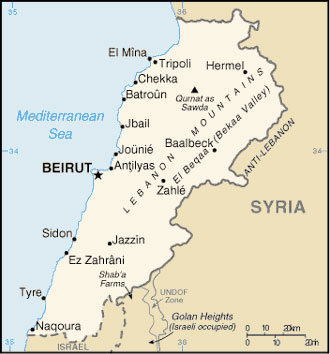
Location: eastern Mediterranean Sea, between Syria and Israel
Capital: Beirut
Area: 10,452sq km
Coastline: 225 km
Elevation extremes:
lowest point: Mediterranean Sea 0 m
highest point: Qurnat as Sawda' 3,088 m
Official language: Arabic
Spoken languages: Arabic, French, English, Armenian
Population: 3,578,036
Age structure: 0-14 years: 28%
15-64 years: 65%
65 years and over: 7%
Currency: Lebanese Lira
Member: Arab League
Lebanon has a 220km long coastline on the eastern Mediterranean. It is bordered on the north and east by Syria, on the south by Israel. It has an area of 10,452 sq km and a population of 4 million. Lebanon is divided into 6 muhafazat (governorates): Beirut, with the capital in Beirut, North Lebanon, with the capital in Tripoli, Mount Lebanon, with the capital in Baabda; Beqaa, with the capital in Zahleh; South Lebanon, with the capital in Saida, and Nabatiyyeh, with the capital in Nabatiyyeh.
It is a founding member of the Arab League.
Lebanon’s location at the crossroads of three continents has given it special significance since ancient times. It was home to the Phoenicians, maritime traders whose culture flourished for 2000 years from 2700 BC; the ruins of their cities are in Tyre, Sidon, Byblos and Beirut. Alexander the Great conquered Tyre by extending its causeway to the mainland, a project that took 7 months. It was a territory of the Roman Empire; their temples to Jupiter, Bacchus and Venus are in Baalbeck .The Crusaders captured Tripoli and Byblos and built fortresses.
It is the point of entry of many civilizations into the Arab world, and helped spread learning, science and civilization from the Islamic world to the western parts of the Mediterranean.
The terrain is divided into five long topographic areas, stretching from north to south: the shoreline which is rocky from Beirut to the north, and sandy south of the capital. This mountain range descends into the Beqaa valley, Lebanon’s fertile agricultural plain. The agricultural products are citrus, bananas, grapes, apples, peaches, tomatoes, vegetables, olives; sheep and goats.
Lebanon is virtually a microcosm of the whole world. The country has a temperate Mediterranean climate: hot and dry in summer, mild to cool in winter with plenty of rainfall in winter. The land is dominated by two mountain ranges with a rift valley in between. All run parallel to a 225 km sandy and rocky coastline. The coastal plain is 2-3km wide. The highest peak at 3028m is Qurnat as Sawda’ .It is covered in snow most of the year.
Between the mountain ranges are deep valleys with swamps, forests more than 3000 years old, abundant rivers and springs and thousands of natural springs, all of which add to its diverse flora and fauna. A total of 369 bird species have been recorded in Lebanon.
There are several protected areas in Lebanon: Palm Island Nature Reserve, Horsh Ehden, Al Shouf Cedars Nature Reserve , Tyre Coastal Nature Reserve and Wadi Qadisha., Ammiq Swamp in the western Beqaa Valley an unprotected wetland.
Other areas of natural beauty are:
Wadi Jhannam: A spectacular gorge in a very remote area of North Lebanon.
Qammoua Cedars: a Cedar of Lebanon grove in North Lebanon; the area also includes large juniper trees, survivors of forests that were cut down by the Ottomans and French.
Tannourin and Jaj Cedars: Cedar trees growing in remote high mountains in the hinterlands of Byblos
Nahr Ibrahim Gorge: a deep valley south of Byblos, spectacular scenery and many rare plants.
Two rivers rise in the watershed near Baalbeck: the Litani, 160km long , flows south into the hill region of the southern Beqaa valley, where it makes a turn to the west and it thereafter called the Qasimiyah River.The Orontes (Nahr al Asi, meaning rebel, because it flows north) is 570 km long, travels north through Syria till it reaches the Mediterranean in Turkey. The Litani is the only major river in southwest Asia that does not cross an international boundary. Other rivers are the Zahrani, al Awali, Nahr ad Damour, Nahr Ibrahim, Nahr Abu Ali, all of which flow east to the sea.
Lebanon is the educational center of the Middle East; graduates of its many universities in medicine, engineering, law, literature, work in other Arab countries.
Lebanon has a free market economy based on private enterprise and a commercial tradition; the government endorses bank secrecy, no restrictions on foreign investment, no restrictions on foreign exchange and money transfer.
The 1975-1991 civil war greatly damaged Lebanon’s infrastructure and its position as a banking center for the Middle East, but time and relative stability has helped restore health to the economy.
Lebanon is a tourist destination in winter for skiing and in summer for its many beaches.
Cities: Beirut, Tripoli, Saida, Tyre, Byblos, Baalbeck, Zahleh
Nature reserves: Al Shouf Cedars Nature Reserve, Horsh Ehden ,Palm Island Nature Reserve, Tyre Coastal Nature Reserve, Wadi Qadisha
Lebanon’s Constitution, Universities, Tourism


